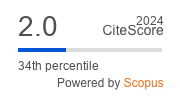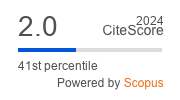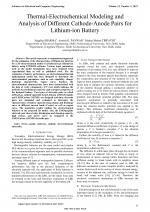| 3/2021 - 7 |
Thermal-Electrochemical Modeling and Analysis of Different Cathode-Anode pairs for Lithium-ion BatterySHARMA, S. |
| Extra paper information in |
| Click to see author's profile in |
| Download PDF |
Author keywords
anode, batteries, cathode, electrochemical, electrodes
References keywords
lithium(36), electrochemical(25), battery(23), batteries(21), thermal(19), power(14), sources(13), model(13), energy(13), jjpowsour(10)
Blue keywords are present in both the references section and the paper title.
About this article
Date of Publication: 2021-08-31
Volume 21, Issue 3, Year 2021, On page(s): 57 - 64
ISSN: 1582-7445, e-ISSN: 1844-7600
Digital Object Identifier: 10.4316/AECE.2021.03007
Web of Science Accession Number: 000691632000007
SCOPUS ID: 85115236923
Abstract
This article represents a computational approach for the estimation of the characteristics of lithium-ion batteries for a 2D electrochemical model of cylindrical type lithium-ion battery using COMSOL software. Various input parameters used in the model formulation have been obtained from experimental data as well as published work. For the evaluation of battery performance, an electrochemical-thermal mathematical model has been designed to determine the electrochemical parameters such as rate capability, charge/discharge characteristic, ragone curve. Further, the electrochemical characteristics have been characterized with the help of cyclic voltammetry (CV) test which indicates the uniform electrochemical reactivity and transport properties of the designed battery. Two types of electrode pairs in which LiMn2O4 as cathode materials form LiMn2O4 (LMO)/Graphite and LMO/Carbon (MCMB) are designed and these electrode pairs are simulated and evaluated to determine the characteristics of battery material using charge and discharge curve at different current loads (C-rates) as well as ragone curve. The simulation results validate the electrochemical behavior of the proposed 2D model. Also, the LMO/graphite electrode pair shows better discharging and charging capacity, high energy, and power curve as compared to the LMO/Carbon (MCMB) electrode pair. |
| References | | | Cited By «-- Click to see who has cited this paper |
| [1] M. Hannan, M. Hoque, A. Mohamed, A. Ayob, "Review of Energy Storage Systems for Electric Vehicle Applications: Issues and Challenges" Renewable and Sustainable Energy Reviews 69, p.p. 771-789, 2017. [CrossRef] [SCOPUS Times Cited 843] [2] X. Lu, "Application of the Nernst-Einstein Equation to Concrete" Cement, and Concrete Research 27 (2), p.p. 293-302,1997 [CrossRef] [SCOPUS Times Cited 237] [3] M. Park, X. Zhang, M.chung, G. B. Less, A. M. Sastry, A Review of Conduction Phenomenon in Li-ion batteries" Journal of Power Sources 195 (24), 7904-7929, 2010. [CrossRef] [4] T. R. Tanim, C. D. Rahn, C. Y .Wang, A Temperature Dependent, Single particle, Lithium ion Cell Model including Electrolyte Diffusion" Journal of Dynamic Systems, Measurement, and Control, vol.1, p.p. 137, 2015. [CrossRef] [SCOPUS Times Cited 1481] [5] R. Darling, J. Newman, "Modeling a Porous Intercalation Electrode with Two Characterstic Particle Sizes" Journal of the Electrochemical Society, vol. 144 (12), p.p. 4201-4208, 1997. [CrossRef] [6] J. Xu, Y. Wu, S. Yin, "Investigation of Effects of Design Parameters on the Internal Short-circuit in cylindrical lithium-ion batteries" RSC advances 7 (24), 14360-14371 (2017). [CrossRef] [SCOPUS Times Cited 37] [7] A. Nazari, S. Farhad, "Heat Generation in Lithium ion Batteries with Different Nominal Capacities and Chemistries" Applied Thermal Engineering 125, p.p. 1501-1517, 2017. [CrossRef] [SCOPUS Times Cited 177] [8] J. Baron, G. Szymanski, J. Lipkowski, "Electrochemical Methods to Measure Gold Leaching Current in an Alkaline Thiosulfate Solution" Journal of Electroanalytical Chemistry 662 (1), p.p. 57-63, 2011. [CrossRef] [SCOPUS Times Cited 19] [9] S. Venkatraman, J. Choi, A. Manthiram, "Factors Influencing the Chemical Lithium Extraction Rate from Layered LiNi1-y-zCoyMnzO2 cathodes" Electrochemistry Communications 6 (8), p.p. 832-837, 2004. [CrossRef] [SCOPUS Times Cited 88] [10] M. Wu, B. Xu, and C. Ouyang, "Physics of Electron and Lithium ion Transport in Electrode Materials of Li-ion Batteries" Chinese Physics B 25 (1), 018206 2015. [CrossRef] [SCOPUS Times Cited 80] [11] E. Hosseinzadeh, J. Marco, P. Jennings, "Electrochemical- Thermal Modelling and Optimization of Lithium-ion Battery Design Parameters Using Analysis of Variance" Energies 10 (9), 1278 2017. [CrossRef] [SCOPUS Times Cited 68] [12] A. Jokar, B. Rajabloo, M. Desilets, M. Lacroix, "Reviews of Simplified Pseudo-Two-Dimensional Models of Lithium-ion Batteries"Journal of Power Sources 327, p.p. 44-55, 2016. [CrossRef] [SCOPUS Times Cited 469] [13] N. Jin, D. L. Danilov, P. M. Van den Hof, M. Donkers, "Optimization of Current Excitation for Identification of Battery Electrochemical Parameters based on Analytic Sensitivity Expression" International Journal of Energy Research 42 (7), p.p. 2417-2430, 2018. [CrossRef] [SCOPUS Times Cited 82] [14] K. Uddin, S. Perera, W. D. Widanage, L. Somerville, J. Marco, Characterising Lithium-ion Battery Degradation through the dentification and Tracking of Electrochemical Battery Model Parameters" Batteries 2 (2), 13, 2016. [CrossRef] [SCOPUS Times Cited 157] [15] Y. Huang, H. Lai, "Effect of Discharge Rate on Electrochemical and Thermal Characterstics of LiFePO4/Graphite Battery" Applied Thermal Engineering 157, 113744 2019. [CrossRef] [SCOPUS Times Cited 43] [16] J. Yang, X. Wei, H. Dai, J. Zhu, X. Xu, "Lithium-ion Battery Internal Resistance Model Based on the Porous Electrode Theory" IEEE Vehicle Power and Propulsion Conference (VPPC), 2014. [CrossRef] [SCOPUS Times Cited 8] [17] P. Wu, J. Romberg, H. Ge, Y. Zhang, J. Zhang, Electrochemical-Thermal Coupled Model of Lithium-Ion Batteries for Low Temperature Charging, in: Soc. Automot. Eng. SAE-China Congr., Springer, 2016: pp. 123-132. [CrossRef] [SCOPUS Times Cited 2] [18] J. Newman, W. Tiedmann, "Porous-Electrode Theory with Battery Applications" AICHE Journal, vol. 21(1), p.p. 25-41, 1975. [CrossRef] [SCOPUS Times Cited 1185] [19] S. Srivastav, P. Tammela, D. Brandell, M. Sjodin, "Understanding Ionic Transport in Polyyyrole/Nanocellulose Composite Energy Storage Devices" Electrochimica Acta 182, p.p. 1145-1152, 2015. [CrossRef] [SCOPUS Times Cited 14] [20] A. Melcher, C. Ziebert, M. Rohde, H. J. Seifert, "Modelling and Simulation of Thermal Runaway Behavior of Cyclindrical Li-ion Cells Computing of Critical Parameters" Energies 9 (4), 292, 2016. [CrossRef] [SCOPUS Times Cited 80] [21] C. Ziebert, A. Melcher, B. Lei, W. Zhao, M. Rohde, H. Seifert, "Electrochemical-Thermal Characterization and Thermal Modeling for Batteries" Emerging Nanotechnologies in Rechargeable Energy Storage Systems (Elsevier), pp. 195-229, 2017. [CrossRef] [22] K. Li, J. Yan, H. Chen, Q. Wang, "Water Cooling Based Strategy for Lithium-ion Battery Pack Dynamic Cycling for Thermal Management System" Applied Thermal Engineering 132, p.p. 575-585, 2018. [CrossRef] [SCOPUS Times Cited 146] [23] Z. Khalik, H. J. Bergveld, M. Donkers," Aging-Aware Charging of Lithium-ion Batteries using an Electrochemistry-Based Model with Capacity-loss Side Reactions" American Control Conference (ACC), 2020. [CrossRef] [SCOPUS Times Cited 12] [24] J. Li, D. Wang, L. Deng, Z. Cui, C. Lyu, L. Wang, M. Pecht, "Aging Mode Analysis and Physical Parameter Identification based on a Simplified Electrochemical Model for Lithium-ion Batteries" Journal of Energy Storage 31, 101538, 2020. [CrossRef] [SCOPUS Times Cited 53] [25] Y. Qi, T. Jang, V. Ramadesigan, D. T. Schwartz, V. R. Subramanian, "Is There a Benefit in Employing Graded Electrodes for Lithium-ion Batteries?" Journal of The Electrochemical Society 164 (13), A3196 2017. [CrossRef] [SCOPUS Times Cited 62] [26] N. Li, L. Fu, K. Jiang, "Gas Evolution and The Effects on Ionic Transport inside the Lithium-ion Battery" Engineering Computations, 2019. [27] P. R. Nileshwar, A. McGordon, T. Ashwin, D. Greenwood, "Parametric Optimization Study of a Lithium-ion Cell" Energy Procedia 138, p.p. 829-83, 2017. [CrossRef] [SCOPUS Times Cited 17] [28] J. Xu, B. Liu, X. Wang, D. Hu, "Computational model of 18650 Lithium-ion Battery with Coupled Strain Rate and SOC Dependencies "Applied Energy 172, p.p. 180-189 2016. [CrossRef] [SCOPUS Times Cited 257] [29] Y. Liu, S. Tang, L. Li, F. Liu, L. Jiang, M. Jia, Y. Ai, C. Yao, H. Gu, "Confining Ultrasmall Bimetallic Alloys in Porous N-Carbon for Use as Scalable and Sustainable Electrocatalysts for Rechargeable Zn-air Batteries" Journal of Alloys and Compounds, 156003, 2020. [30] Y. Dai, V. Srinivasan, "On Graded Electrode Porosity as a Design Tool for Improving the Energy Density of Batteries" Journal of The Electrochemical Society 163 (3), A406, 2015. [CrossRef] [SCOPUS Times Cited 101] [31] S. Panchal, I. Dincer, M. Agelin-Chaab, R. Fraser, M. Fowler, "Transient Electrochemical Heat Transfer Modeling and Experimental Validation of a Large Sized LiFePO4/Graphite Battery" International Journal of Heat and Mass Transfer 109, p.p. 1239-1251, 2017. [CrossRef] [SCOPUS Times Cited 140] [32] K. Somasundaram, E. Birgersson, A. S. Mujumdar, "Thermal-Electrochemical Model for Passive Thermal Management of a Spiral-Wound Lithium-ion Battery" Journal of Power Sources 203, p.p. 84-96, 2012. [CrossRef] [SCOPUS Times Cited 163] [33] S. Wang, J. Wang, Y. Gao, "Exfoliation of Covalent Organic Frameworks into Few-Layer Redox-Active Nanosheets as Cathode Materials for Lithium-ion Batteries (2017),139, 12, 4258-4261. [CrossRef] [SCOPUS Times Cited 880] [34] K. Shaju, G. S. Rao, B. Chowdari, "X-Ray Photoelectron Spectroscopy and Electrochemical Behaviour of 4V Cathode, Li (Ni1/2Mn1/2) O2 Electrochimica Acta 48 (18), p.p. 2691-2703, 2003. [CrossRef] [SCOPUS Times Cited 132] [35] H. Li, C. Liu, A. Saini, Y. Wang, H. Jiang, T. Yang, L. Chen, C. Pan, H. Shen, "Coupling Multi-Physics Simulation and Response Surface Methodology for the Thermal Optimization of Ternary Prismatic Lithium-ion Battery" Journal of Power Sources 438, 226974, 2019. [CrossRef] [SCOPUS Times Cited 36] [36] C. Edouard, M.Petit, C. Forgez, J.Bernard, R.Revel, "Parameter Sensitivity Analysis of a Simplified Electrochemical and Thermal Model for Li-ion Batteries Aging" Journal of Power Sources, vol. 33, p.p. 482-494, 2016. [CrossRef] [SCOPUS Times Cited 95] [37] L. Zhang, C. Lyu, L. Wang, W.Luo, K. Ma, "Thermal-Electrochemical Modeling and Parameter Sensitivity Analysis of Lithium-ion Battery" Chemical Engineering, Vol. 33, p.p. 943-948, 2013. [38] Y. H. Chen, C. W. Wang, X. Zhang, A. M. Sastry, "Porous Cathode Optimization for Lithium Cells: Ionic and Electronic Conductivity, Capacity, and Selection of Materials" Journal of Power Sources, vol. 195(9), p.p. 2851-2862, 2010. [CrossRef] [SCOPUS Times Cited 230] [39] W. Wu, X. Xiao, X. Huang, "The Effect of Battery Design Parameters on Heat Generation and Utilization in a Li-ion cell" Electrochemica Acta, vol. 83, p.p. 227-240, 2012. [CrossRef] [SCOPUS Times Cited 105] [40] S. Golmon, K. Maute, M. L. Dunn, "A Design Optimization Methodology for Li+ Batteries" Journal of Power Sources, vol.253, p.p. 239-250, 2014. [CrossRef] [SCOPUS Times Cited 82] [41] J. Li, Y. Cheng, L. Ai, M. Jia, S. Du, B. Yin, S. Woo, H. Zhang, "3D Simulation on the Internal Distributed Properties of Lithium-ion Battery with Planar Tabbed Configuration" Journal of Power Sources, vol. 293, p.p. 993-1005, 2015. [CrossRef] [SCOPUS Times Cited 122] [42] J. Li, Y. Cheng, M. Jia, Y. Tang, Y. Lin, Z. Zhang, Y. Liu, "An Electrochemical-Thermal Model Based on Dynamic Responses for Lithium Iron Phosphate Battery" Journal of Power Sources, vol. 255, p.p. 130-143, 2014. [CrossRef] [SCOPUS Times Cited 201] [43] A. M. Bizeray, S. Zhao, S. R. Duncan, D. A. Howey, "Lithium-ion Battery Thermal-Electrochemical Model-Based State Estimation using Orthogonal Collocation and a Modified Extended Kalman Filter" Journal of Power Sources, vol. 296, p.p. 400-412, 2015. [CrossRef] [SCOPUS Times Cited 235] [44] J. M. Tarascon, M. Armand, "Issues and Challenges Facing Rechargeable Lithium Batteries" Materials for Sustainable Energy: A Collection of Peer-Reviewed Research and Review Articles from Nature, p.p. 171-179, 2011. [CrossRef] [SCOPUS Times Cited 523] [45] W. Tong, K. Somasundaram, E. Birgersson, A. S. Mujumdar, C. Yap, "Thermal-Electrochemical Model for Forced Convection Air Cooling of a Lithium-ion Battery Module" Applied Thermal Engineering 99, 672-682 (2016). [CrossRef] [SCOPUS Times Cited 114] [46] M. Doyle, T.F. Fuller, J. Newman, "Modelling of Galvanostatic Charge and Discharge of the Lithium/Polymer insertion Cell" Journal of the Electrochemical Society, vol. 140(6), p.p. 1526, 1993. [CrossRef] [SCOPUS Times Cited 3467] [47] M. Doyle, J. Newman, A. S. Gozdz, C. N. Schmutz, J.M. Tarascon, "Comparison of Modeling Predictions with Experimental Data from Plastic Lithium-ion Cells" Journal of Electrochemical Society, vol. 143(6), 1890, 1996. [CrossRef] [SCOPUS Times Cited 1427] [48] T. F. Fuller, M. Doyle, J. Newman, "Simulation and Optimization of the Dual Lithium-ion Insertion Cell" Journal of Electrochemical Society, vol. 141(1), 1, 1994. [CrossRef] [SCOPUS Times Cited 1717] [49] L. L. Lam, R. B. Darling, "Theory of Battery Aging in a Lithium-ion Battery: Capacity Fade, Non-Linear Ageing and Lifetime Prediction" Journal of Power Sources, vol. 276, p.p. 195-202, 2015. [50] P. Arora, R. E. White, M. Doyle, "Capacity Fade Mechanism and Side Reactions in Lithium-ion Batteries" Journal of Electrochemical Society vol. 145 (10), 3647, 1988. [CrossRef] [SCOPUS Times Cited 1305] [51] P. Ramadass, B. Haran, R. White, B. N. Popov, "Mathematical Modeling of the Capacity Fade of Li-ion Cells" Journal of Power Sources, vol. 123 (2), p.p. 230-240, 2003. [CrossRef] [52] F. Laman and K. Brandt, "Effect of Discharge Current on Cycle Life of a Rechargeable Lithium Battery" Journal of Power Sources, vol. 24 (3), p.p. 195-206, 1988. [CrossRef] [SCOPUS Times Cited 47] [53] A. Dogan, S. Bahceci, F. Daldaban, M. Alci, "Optimization of Charge/Discharge Co-ordination to Satisfy Network Requirements Using Heuristic Algorithms in Vehicle-to-Grid Concept" Advances in Electrical and Computer Engineering, vol. 18 (1), p.p. 121-131, 2018. [CrossRef] [Full Text] [SCOPUS Times Cited 17] [54] S. Zhang, X. Guo, X. Zhang, "Modelling of Back-Propogation Neural Network Based State-of-Charge Estimation for Lithium-ion Batteries with Consideration of Capacity Attenuation" Advances in Electrical and Computer Engineering, vol. 19 (3), p.p. 3-11, 2019. [CrossRef] [Full Text] [SCOPUS Times Cited 27] [55] D. Petreus, D.Moga, R. Galatus, R. A. Munteanu, "Energy Harvesting with Supercapacitor-Based Energy Storage" Advances in Electrical and Computer Engineering, vol. 8 (2), p.p. 15-22, 2008. [CrossRef] [Full Text] [SCOPUS Times Cited 24] [56] Y. J. Liu, X. H. Li, H. J. Giu, "Overcharge performance of LiMn2O4 / graphite battery with large capacity" J. Cent. South Univ. Technol. Vol. 16, p.p. 0763-0767, 2009. [CrossRef] [SCOPUS Times Cited 8] [57] W. A. Appiah, J. Park, S. Byun, M. H. Ryou, Y. M. Lee, "A Mathematical model for cyclic aging of spinel LiMn2O4 /Graphite Lithium-ion cells" Journal of the Electrochemical Society, vol. 163 (13), p.p. A2757-A2767, 2016. [CrossRef] [SCOPUS Times Cited 37] [58] A. J. Smith, J.C. Burns, J. R. Dahn, "High-precision differential capacity analysis of LiMn2O4/Graphite cells" Electrochemical and solid-state letters, vol. 14 (4), p.p. A39, 2011. [CrossRef] [SCOPUS Times Cited 82] [59] J. Caihua, T. Zilong, D. Shiqing, H. Ye, W. Shitong, Z. Zhong Tai, "High performance Carbon-Coated mesoporous LiMn2O4 cathode materials synthesized form a novel hydrated layered -spinel lithium manganate composite" Journal of RCS Advances, vol. 7, p.p. 3746-3751, 2017. [CrossRef] [SCOPUS Times Cited 29] [60] S. Vadivel, P. Nutthaphon, W. Juthaporn, S, Montree, "High-performance spinel LiMn2O4@carbon core-shell cathode materials for Li-ion Batteries" Journal of Sustainable Energy & Fuels, vol. 3, p.p. 1988-1994, 2019. [CrossRef] [61] S. Sharma, A. K. Panwar, M. M. Tripathi, Storage technologies for electric vehicles, J. Traffic Transp. Eng. Engl. Ed. 7 (2020) 340-361. [CrossRef] [SCOPUS Times Cited 140] Web of Science® Citations for all references: 0 SCOPUS® Citations for all references: 17,103 TCR Web of Science® Average Citations per reference: 0 SCOPUS® Average Citations per reference: 276 ACR TCR = Total Citations for References / ACR = Average Citations per Reference We introduced in 2010 - for the first time in scientific publishing, the term "References Weight", as a quantitative indication of the quality ... Read more Citations for references updated on 2025-07-02 12:18 in 376 seconds. Note1: Web of Science® is a registered trademark of Clarivate Analytics. Note2: SCOPUS® is a registered trademark of Elsevier B.V. Disclaimer: All queries to the respective databases were made by using the DOI record of every reference (where available). Due to technical problems beyond our control, the information is not always accurate. Please use the CrossRef link to visit the respective publisher site. |
Faculty of Electrical Engineering and Computer Science
Stefan cel Mare University of Suceava, Romania
All rights reserved: Advances in Electrical and Computer Engineering is a registered trademark of the Stefan cel Mare University of Suceava. No part of this publication may be reproduced, stored in a retrieval system, photocopied, recorded or archived, without the written permission from the Editor. When authors submit their papers for publication, they agree that the copyright for their article be transferred to the Faculty of Electrical Engineering and Computer Science, Stefan cel Mare University of Suceava, Romania, if and only if the articles are accepted for publication. The copyright covers the exclusive rights to reproduce and distribute the article, including reprints and translations.
Permission for other use: The copyright owner's consent does not extend to copying for general distribution, for promotion, for creating new works, or for resale. Specific written permission must be obtained from the Editor for such copying. Direct linking to files hosted on this website is strictly prohibited.
Disclaimer: Whilst every effort is made by the publishers and editorial board to see that no inaccurate or misleading data, opinions or statements appear in this journal, they wish to make it clear that all information and opinions formulated in the articles, as well as linguistic accuracy, are the sole responsibility of the author.



